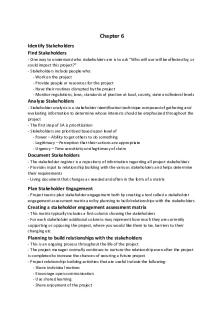Mintzberg Org Types - Summary Master in Business Management PDF

| Title | Mintzberg Org Types - Summary Master in Business Management |
|---|---|
| Author | Sriharsha Yalla |
| Course | Master in Business Management |
| Institution | Amity University |
| Pages | 2 |
| File Size | 156.8 KB |
| File Type | |
| Total Downloads | 100 |
| Total Views | 136 |
Summary
SUMMARY OF MINTZBERG ORG TYPES...
Description
Mintzberg's Organization Types Henry Mintzberg
born September 2, 1939 in Canada renowned academic and author on business and management published about 170 articles and 17 books recently published book: Managing the Myths of Health Care
Six basic parts of the organization 1. Ideology
halo of beliefs and traditions; norms values and culture
2. Strategic Apex
top management → role is to interpret/define mission of organization and to ensure its objectives are consistens with mission
3. Operating Core
operations, operational processes → people who perform basic work of producing the products
4. Middle Line
middle management → Form a chain joining the strategic apex to the operating core by the use of delegated formal authority
5. Technostructure
analysts that design systems, processes, etc
6. Support Staff
support outside of operating workflow
Organization Types Entrepreneurial Organization: • • • •
entrepreneurial company has informal, non-standardized structure and rules direct supervision key part of organization is Strategic Apex Type of organization has a simple and flat structure
→ Example: start-up companies, one-person company, family companies
Machine Organization (Bureaucracy) • • • • • • •
defined by its standardization strict hierarchical control Key part of organization is Technostructure Tight vertical structure, functional lines go all the way to the top → allows top managers to maintain centralized control jobs are defined, formal planning process with budgets and audits and procedures will regularly be analyzed for efficiency often large manufacturers, government agencies and service firms that perform routine tasks
→ Example: McDonald's Professional Organization • • • • • •
is complex, lots of rules and procedures difference is that prof. org. rely on highly trained professionals who demand control of their own work allows different professionals to work within a social structure while maintaining their own work A key principle of professional organizations is the autonomy Structure is typical for org. who has a large number of knowledge workers disadvantage: lack of control that senior executives can exercise, because authority and power are spread down through the hierarchy
→ Example: Universities
Divisional (Diversified) Organization • • • • • •
has many different product lines and business units central headquarter supports number of autonomous divisions that make own decisions and have own unique structure large and mature organizations, that have a variety of brands, produce a wide range of products or operate in different geographical regions allows managers to maintain more control and accountability (other than in machine structure) day-to-day decision making → central team can focus on main strategic plans key part of organization is Middle line
→ Example: Apple Innovative Organization (Adhocracy) • • • • •
best suited to traditional organization highly flexible → pool of talents → workers move from team to team relatively low standardization and formality with little hierarchy, Its form is often driven by the need for speed operation is based on trust in others to be able to do their jobs well
→ Example: Google Missionary Organization • • • • •
achieve control through standardization of norms work is very clear, focused, inspiring and distinctive small tasks and units are clear through the clarity of the mission Centralization through leaders who want to achieve the goal of the clear mission (decentralization) key part of organization is Ideology
→ Example: Fairphone Political Organization • • • •
In a political system there is typically little or no external competition → people turn inwards to compete organization best described in terms of power, not structure different work deviations are possible, but the choice will always be political can enforce of destroy hierarchy of authority → professional and innovative organization are particularly susceptible to organizational politics, because of their relatively weak system of authority
→ Example: Regulatory agencies, Monopolies
Sources: Applying Mintzberg’s Theories on Organizational Configuration, Victoria Lemieux, 1998 https://www.slideshare.net/CommunicationKC/organizational-structure-and-comm-incl-assignm-comm-kc-15755805 http://study.com/academy/lesson/henry-mintzberg-organizational-structure.html#lesson https://www.mindtools.com/pages/article/newSTR_54.htm http://smallbusiness.chron.com/different-types-organizational-structure-723.html http://www.accaglobal.com/ie/en/student/exam-support-resources/fundamentals-exams-study-resources/f1/technical-articles/mintzbergtheory.html http://www.comindwork.com/weekly/2016-11-14/productivity/six-basic-parts-of-the-organization-by-mintzberg...
Similar Free PDFs

Mintzberg 1975 (in Pugh 1997)
- 12 Pages

Types of business activity
- 2 Pages

Types of business
- 31 Pages

Mintzberg teoria
- 5 Pages

Utility types - summary
- 2 Pages

master in coordinamento - tesine
- 10 Pages

Master in Globalisation (appunti)
- 17 Pages

Business management
- 88 Pages
Popular Institutions
- Tinajero National High School - Annex
- Politeknik Caltex Riau
- Yokohama City University
- SGT University
- University of Al-Qadisiyah
- Divine Word College of Vigan
- Techniek College Rotterdam
- Universidade de Santiago
- Universiti Teknologi MARA Cawangan Johor Kampus Pasir Gudang
- Poltekkes Kemenkes Yogyakarta
- Baguio City National High School
- Colegio san marcos
- preparatoria uno
- Centro de Bachillerato Tecnológico Industrial y de Servicios No. 107
- Dalian Maritime University
- Quang Trung Secondary School
- Colegio Tecnológico en Informática
- Corporación Regional de Educación Superior
- Grupo CEDVA
- Dar Al Uloom University
- Centro de Estudios Preuniversitarios de la Universidad Nacional de Ingeniería
- 上智大学
- Aakash International School, Nuna Majara
- San Felipe Neri Catholic School
- Kang Chiao International School - New Taipei City
- Misamis Occidental National High School
- Institución Educativa Escuela Normal Juan Ladrilleros
- Kolehiyo ng Pantukan
- Batanes State College
- Instituto Continental
- Sekolah Menengah Kejuruan Kesehatan Kaltara (Tarakan)
- Colegio de La Inmaculada Concepcion - Cebu







